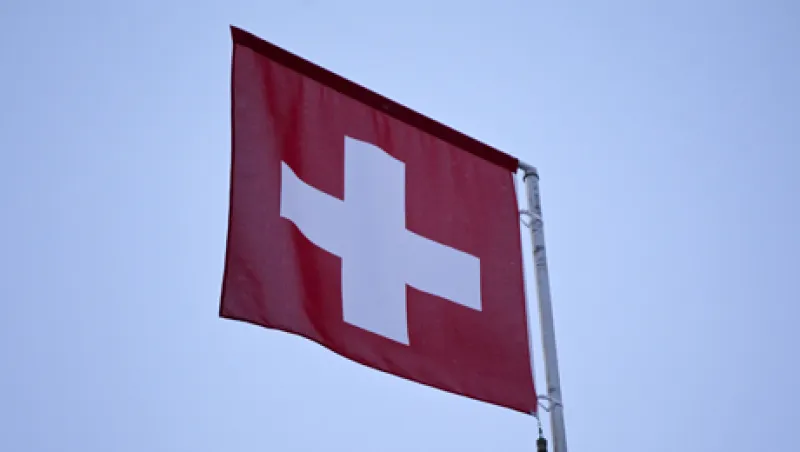Mario Draghi has done something for the Swiss franc (CHF) that Thomas Jordan, his Swiss central bank counterpart, could never have done on his own. He has prompted serious discussion — albeit tentative at this stage — of when it will depreciate.
Earlier this year some hedge funds were placing new bets that the Swissie’s ceiling against the euro — set by the Swiss National Bank (SNB) at CHF 1.20 ($1.48) in September 2011 — would collapse because the SNB would not be able to buy euros fast enough to counter the exodus into Swiss francs by investors fearful of the single European currency’s collapse. The Swissie has huddled close to that level ever since.
However, Draghi’s September 6 announcement that the European Central Bank (ECB) would buy potentially unlimited amounts of euro zone debt changed thinking about the Swiss franc in two ways.
By improving investor sentiment towards the euro zone economy in particular and the world economy in general, it prompted funds to trim or liquidate the full gamut of “tail risk” strategies — bets on a worse-than-consensus outcome for the world economy. The more conventional of these included credit default swaps on peripheral euro zone government debt; the more unconventional included call options on the Swiss franc against the euro — a bet that the skies would fall in over the euro zone economy and that the ceiling would consequently cave in for the Swissie.
The ECB’s initiative also prompted speculation that a revival of euro zone economic fortunes might even reduce the value of the Swiss franc — bringing it significantly below the ceiling for the first time since the ceiling was installed. In the days after Draghi’s announcement, the franc even dipped to close to 1.22 against the euro, though it has made up much of its lost ground since then.
Talk of a move downwards in the Swissie has been boosted in part by a sense among many investors that the SNB is as resolutely determined as ever to block any move upwards and through the ceiling, by buying euros — even though Draghi’s action is probably the most important driver of all.
Investors had speculated that Jordan, who took over at the SNB in January, would prove less of a robust defender of the ceiling than his predecessor Philip Hildebrand, who devised it. However, this speculation has subsided because of his enthusiastic verbal support of the ceiling in recent months. Jordan declared in June, for example: “We are enforcing the minimum exchange rate with all determination because it is the right monetary policy.”
The SNB certainly has a strong motivation to keep the ceiling in operation. The strength of the Swiss franc has already sapped the competitiveness of Swiss exports, which are equivalent to 54 percent of GDP. It has also pushed Switzerland into deflation — and long periods of deflation tend to damage economies — by encouraging consumers to defer spending, for example. Even greater strength in the Swiss franc would wreak even greater damage.
Responding to the SNB’s steadfastness, Nomura’s foreign exchange team said earlier this month that as the ceiling “is here to stay, a directional view on EUR/CHF boils down to when we believe EUR/CHF will start to appreciate.”
Nomura is not predicting a fall in the Swiss franc against the euro “in the near term.” However, looking at the Swissie on a purchasing power parity (PPP) basis — how many goods and services that currency could buy in its home country, compared with other currencies in their own countries — an eventual depreciation makes sense. PPP calculations based on figures from the Organization for Economic Cooperation and Development suggest a rate of about CHF 1.83 to the euro — a hefty 51 percent higher than the euro’s current value.
It is also logical, in normal circumstances, to expect depreciation in the Swiss franc against the euro should the euro zone economy show signs of stabilization or even recovery.
However, the Swiss franc’s artificial currency ceiling means it is not in normal circumstances. HSBC estimated, in a note published last week, that if there were no ceiling, the Swiss franc would have risen to the point where it was “trading around parity” against the euro. Others agree with this assessment for what one might call the Swissie’s “true value” — the value at which it would trade without central bank intervention. Assuming a starting point of CHF 1.00, sentiment towards the euro zone would need to improve to a huge degree to bring estimates of the Swiss franc’s true value significantly above the CHF 1.20 ceiling against the euro. At the close of trading on Friday it was slightly below the ceiling, at CHF 1.212.
A further problem with betting on a fall in the Swiss franc is what Ed Lalanne, strategist at Macro Risk Advisors in New York, describes as the “limited upside.” He explains, “Low Swiss inflation and its strong economy have created an underlying long-term trend, over the decades, of Swiss franc appreciation — so the euro can never rise by very much against the Swiss franc.”
Lalanne disagrees, moreover, with the consensus view that there are no cracks visible in the Swiss franc ceiling. “Eventually the Swiss National Bank has got to stop taking on so much risk. If its foreign currency holdings get up to 600 billion Swiss francs — above annual Swiss gross domestic product — and it looks like they’re going to continue upwards from there, the central bank may need to stop intervening.” He adds, “It’s been bitten before by having to sell foreign currency holdings at a loss because the currency held has depreciated against the franc.”
The SNB’s frantic purchase of foreign currency to keep the Swiss franc’s value down has, at least, eased from its July peak of CHF 69 billion worth. However, it still rose by CHF 33 billion in August to reach a record high of CHF 418 billion — 71 percent of Switzerland’s total 2011 gross domestic product of CHF 587 billion. Every month brings it closer to that crucial milestone — a milestone that is likely to set currency traders probing the ceiling for flaws in the plasterwork.






